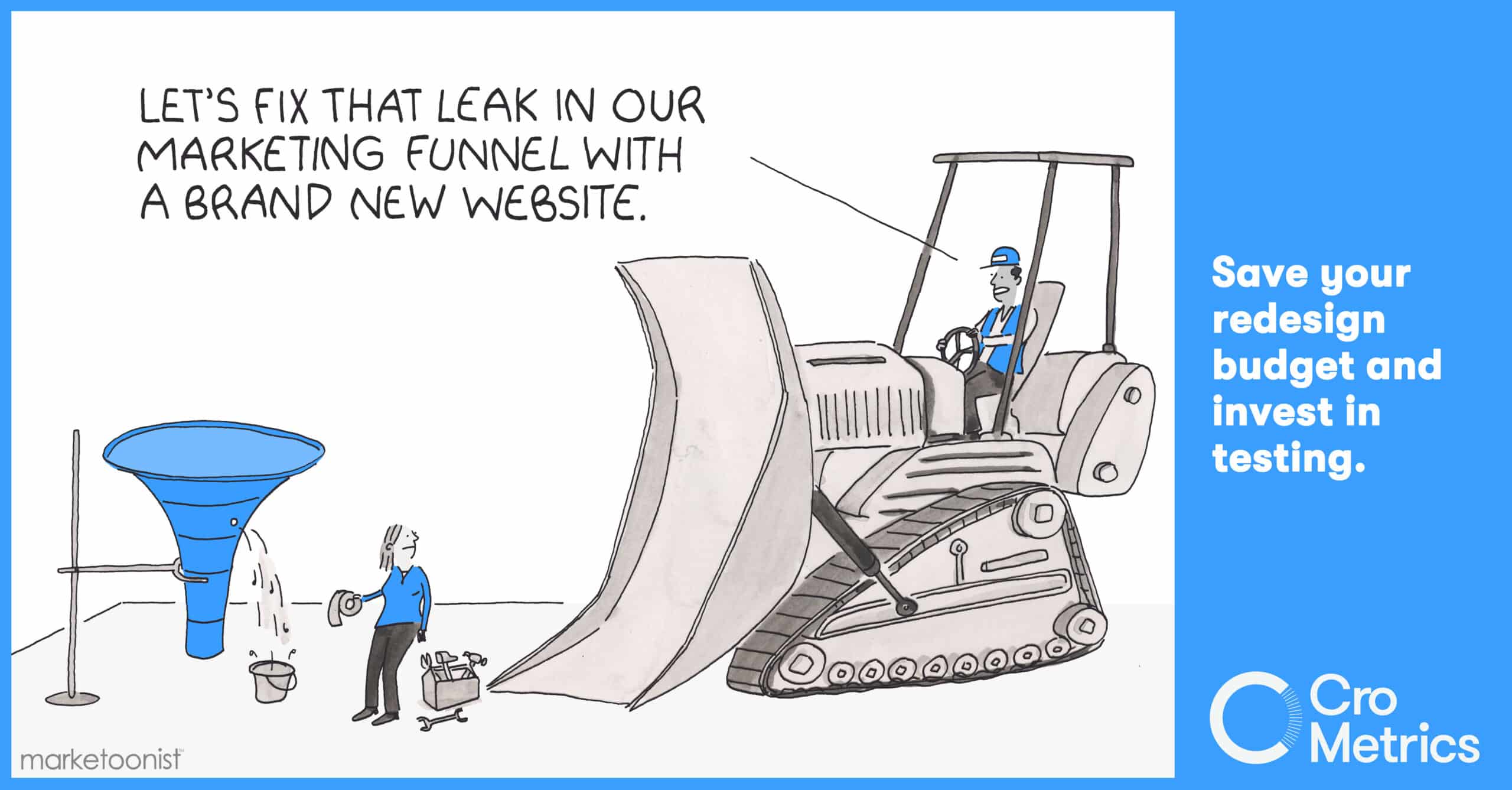Is your organization considering a website redesign that has got you nervous? It’s understandable. We’re nervous for you as well. Did you know that Hubspot found that 68% of marketers did a site redesign in the last 12 months, but as many as 1/3 of them were unhappy with the results?
Not at Amazon. A Forbes article revealed that “Amazon doesn’t start an activity or develop a capability unless and until the team has figured out how it will measure customers’ response.”
Conversion Rate Optimization (CRO) Offers an Effective Alternative to Website Redesign
There are a number of reasons why website redesigns fail to deliver meaningful ROI—from negative impacts on SEO to the sheer cost in terms of money and time. Rather than undertake a complete website redesign, savvy product and marketing teams direct their resources to incremental website updates driven by highly-targeted data focused on Conversion Rate Optimization (CRO).
When it comes down to results, CRO delivers. According to Forrester, “Mature CRO capabilities optimize customer experience, drive loyalty, and ultimately contribute to revenue growth and deliver real competitive advantage.”
With CRO, website redesign happens continuously and is based on testing specific items, such as placement, messaging, design, and content for CTAs and graphic elements. This ensures that any website redesign efforts deliver statistically significant, measurable improvements and tangible results. By focusing on performance, CRO puts good website redesign to productive use, albeit incrementally—not as a bulldoze then rebuild.
Incremental design changes can deliver significant ROI. One of our clients, an executive knowledge-sharing platform, saw an 18% lift in conversions and a 10% lift in leads generated by merely switching the hero image on a key landing page to a more compelling visual. The new graphic provided the missing context and relevance to prospective customers.
CRO Delivers Results by Continuously Testing and Optimizing
CRO’s virtuous cycle of testing and optimization helps achieve improvements in customer experience and business outcomes. With CRO, you know exactly what’s working and what’s not. This allows you to implement conversion-driven website design changes that provide results. For example, one of our nonprofit clients saw a 584% jump in referral email captures after moving the ask to the top navigation across the entire site.
CRO Converts from Visitor to Prospect
You spend a significant portion of your marketing budget driving traffic to your website. CRO turns these visitors into engaged users and buyers and puts website redesign to practical use in a timely manner. Changes are small but ongoing, so your website remains fresh and attractive to search engines, all while increasing revenue and driving engagement.
CRO-centered website redesign work focuses on changes that maximize conversion and performance more than aesthetics. Design changes include reducing friction points by allowing visitors to make choices more easily, using relevant images and messaging, adding CTAs, and updating content to be clearer. And because each change is tested, the results are measurable and proven. You know exactly what impact changes had on the overall conversion-funnel performance.
Which Areas to Optimize
Web analytics tools help prioritize what to concentrate on based on factors such as high-value entry pages, referral traffic, click-through rates, and bounce/exit metrics. Analyzing drop-offs in your conversion funnels, filtered by attributes such as device, traffic source, and visitor types can also reveal testing opportunities. Begin by identifying then optimizing the highest-value pages (often those closest to your conversion metric) rather than taking on a complete website redesign. Once you have results, test and apply your winners on similar pages or flows, and iterate on your test learnings to run potentially higher impact tests now that you understand more about visitor intent and behavior.
CRO Testing for Risk Mitigation
With this incremental approach, changes are smaller but more frequent. The results are near immediate and, because the changes are smaller, so are the risks. Incrementally applying a series of website design updates builds momentum while new tactics are tested and implemented.
Often a simple change to a form’s functionality, format, or the placement of a button yields material results. One of our compliance management clients saw a 31% lift in submissions after reducing the size and number of fields required in its online form. And, one of our global nonprofit partners saw a 35% increase in conversion rate and a 13% lift in revenue after increasing the size of its donation buttons.
It’s also important to acknowledge there is value in negative test results. Nearly all tests reveal invaluable insights on what your customers expect, which leads to iteratively testing changes that solve blockers in leading them to the actions you want them to take. Conversely, you can apply successful tactics to other pages to increase their efficacy. When you get negative results, remember to focus on what worked, not what didn’t work. If something produced a negative result, learn from it, and direct your energy into optimizing your successes.
Considerations when Deciding Web Redesign or CRO
When considering a website redesign versus executing a CRO program, the following questions will help you with this decision:


